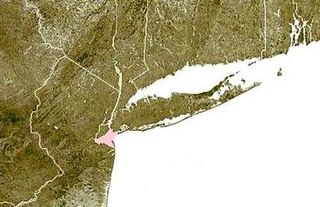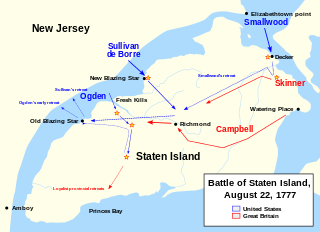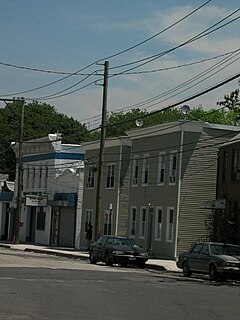This article has multiple issues. Please help improve it or discuss these issues on the talk page . (Learn how and when to remove these template messages)
|


Lookout Place or Fort Hill (also known as Fort Izard) was an American Revolutionary War British garrison, or earthen mound-fortress roughly 44 feet square at the top of La Tourette Hill in Historic Richmondtown, Staten Island, New York. The redoubt was constructed in 1776 by British Regulars during the occupation of Richmond County. General William Howe planned his successful capture of New York City while encamped on the Island, along with 30,000 British and Hessian soldiers joining to suppress the rebellion after the arrival of his brother Admiral Richard Howe. The fort overlooked a fresh water spring about 200 feet directly below (known as the Lord Howe Spring), the Old Mill Road, Fresh Kills which is a tributary of Richmond Creek, St. Andrews Church and the town of Richmond, then referred to as Cuckoldstown, in the valley just below La Tourette Hill.

The American Revolutionary War (1775–1783), also known as the American War of Independence, was an 18th-century war between Great Britain and its Thirteen Colonies which declared independence as the United States of America.
Commonly used to describe the Napoleonic era British foot soldiers, the British Regulars were known for their distinct red uniform and well-disciplined combat performance. Known famously in British folklore as the Red Coats, these hardened soldiers were the backbone of the British Army in the eighteenth and nineteenth centuries.

General William Howe, 5th Viscount Howe, KB, PC was a British Army officer who rose to become Commander-in-Chief of British forces during the American War of Independence. Howe was one of three brothers who had distinguished military careers. In historiography of the American war he is usually referred to as Sir William Howe in distinction to his brother Richard, who held the title of Lord Howe at that time.
The hilltop was widely denuded of trees by the British during the war, allowing the soldiers to have unobstructed views of Lower New York Bay and the Arthur Kill. It is now the La Tourette Golf Course.

Lower New York Bay is a section of New York Bay south of the Narrows, the relatively narrow strait between the shores of Staten Island and Brooklyn. The southern end of the bay opens directly to the Atlantic Ocean between two spits of land, Sandy Hook, New Jersey, and Rockaway, Queens, on Long Island. The southern portion between Staten Island and New Jersey, at the mouth of the Raritan River, is named Raritan Bay. The Hudson Canyon, the ancient riverbed of the Hudson River which existed during the last ice age when the ocean levels were lower, extends southeast from Lower New York Bay for hundreds of miles into the Atlantic Ocean. The nearby part of the Atlantic Ocean between New Jersey and Long Island is the New York Bight.

Arthur Kill, also known as the Staten Island Sound, is a tidal strait and a kill between Staten Island, a borough of New York City, and Union and Middlesex counties in northern New Jersey. It is a major navigational channel of the Port of New York and New Jersey in the United States.
Extensive archeological digs have taken place at the beginning of the 20th century, [1] revealing all manner of British accuetrament, from remnants of weaponry to soldier coat buttons, shoe buckles and pottery fragments. [2]
Robert Rogers created a new unit while encamped at Richmondtown called The Queen's Rangers named after Charlotte, wife of King George III.

The Queen's Rangers, also known as the Queen's American Rangers, and later Simcoe's Rangers, were a Loyalist military unit of the American Revolutionary War. They were named for Queen Charlotte, consort of George III. Formed as a light corps in the tradition of the ranging companies in British service during the Seven Years' War, the Queen's Rangers operated on the flanks and in advance of Crown forces, manning outposts and patrolling, as well as carrying out reconnaissance and raiding operations.














